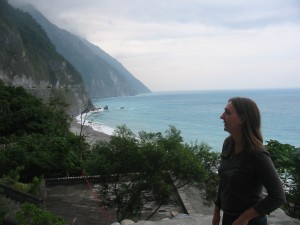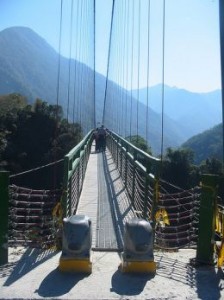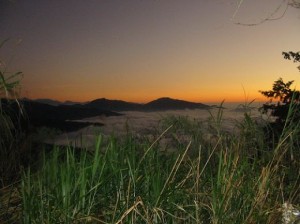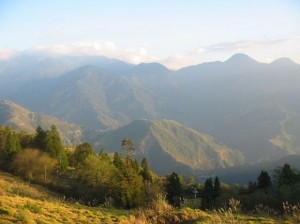Just had an opportunity to go through a lot of my older photos and in doing so realised that I had some terrific photos, and memories, of a trip we took to visit some of the high altitude tea growing areas in Taiwan. Taiwan is not on the regular list of ‘places you absolutely must visit’ however it does have some truly amazing sites and places well worth visiting. Remember, in the not too distant past it was called ‘Formosa’ which loosely translated means Beautiful Island. It certainly does live up to that reputation.
Eastern Coast of Taiwan

We started our journey by travelling down the rugged east coast of Taiwan which faces the Pacific Ocean. Rugged cliffs drop directly into the ocean, giving some astounding glimpses of the wildness of the area. There are some areas, such as Hulien, that have beaches though they are often pebble beaches or dark sand beaches. The white beaches are more commonly found towards the south of the island in the sub-tropical areas. Oh, another interesting fact, the northern part of the country is in the temperate region but the lower part is sub-tropical and you notice the change almost immediately as you’re driving south.
There are some great natural hot springs around the Eastern coasts, and many small hotels and facilities are set up with hot spring baths and pools. During our tenure in Taiwan we became totally addicted to hot springs. There is nothing better than relaxing (usually sans clothes) in a 37 degree natural spring water, watching the sun set over gorgeous mountainous settings, while the temperature drops to five or six degrees. It is exhilarating and one of the most relaxing experiences I have ever enjoyed.
Central Taiwan Mountain Ranges

From Hualien we travelled west over rugged mountain ranges through the small village of Ren-nai and down to Taichung which is a very mild climate city in central Taiwan. While we were not permitted to visit the higher mountainous areas such as the Yushan area we did stop by the Alishan range — yes you have probably heard of Alishan Mountain tea — an oolong that is actually one of my favourites. We also spent some time in the Nantou area where we stayed at a hotel that naturally had hot spring water piped into pools of varying degrees in the hotel grounds and visited with one of the tea farmers who provide us with many of the top quality oolong teas we sell. In spite of there being over 23 million people living in the small island (it’s total area is only around 35,800 square kms–much smaller than Tasmania which is 68,400 square kms) we travelled for kilometres through isolated areas.
Yes, the roads over the mountains were narrow, dangerous and very winding with rock slides a common occurrence especially after rains or post earthquakes, but the view was breathtaking. We were driving down from the Alishan mountain range as the sun was setting — a beautiful time of the day. The sun reflections lit up the whole area with a mystical orange light and at for a good while we were well above the cloud layers. You could look down and see a blanket of clouds covering the ground below, with blue clear skies above. As we began our descent we passed by some farms though at the top it was quite barren and sparse with some vegetation — though not much. At one point we stopped to take a break and walked along a path to the highest point on that particular mountain — and ran out of breath doing so. The mountains are much higher than those you find in Australia so I was not expecting the breathlessness that accompanied very little exertion on my part! Must have not been as fit as I thought I was.

Aside from the great scenic views while travelling around Taiwan there is also plenty of other ‘must see’ locations. I could have spent days in the National Museum, unfortunately the kids weren’t as awed as I was by the treasures on display there. Apparently, when many of the wealthy fled China to settle in Taiwan they brought many of the Chinese national treasure with them including artefacts dating back thousands of years. It is definitely worth setting aside a day to visit the museum.
Then, as with most Asian cities, you have an abundance of outdoor markets that sell everything from food to clothing, and plenty of great restaurants. Be sure to try a Taiwanese “hot pot” meal, the food is great and the fun of cooking your own soup in front of you usually ensures that you will return. Best of all, it is relatively inexpensive to eat out as well–though no where near as cheap as eating out in Thailand.
Sampling Taiwan’s Famous Teas

Finally, there is no better place to experience Taiwan oolong teas. You can visit tea farmers and sample many of their newest teas. They are fresh and prepared perfectly. Some of my favourites are Organic GABA tea, Milk Oolong tea and Ginseng Oolong tea. While there, it’s a great time to shop for Chinese tea sets, clay pots and other utensils that help make brewing tea easy. Some of the tea sets are very expensive, though it is possible to pick up some great sets and teapots at much cheaper prices that you would find sold by local tea retailers here. Definitely a worthwhile place to visit if you are interested in, or sell, teas or teapots.
Hello Robyn- Thank you for all your info on tea and Taiwan. I want to visit the tea farm area but haven’t been to Taiwan. Is there a best time or a worst time to go? What about hotels? many thanks in advance for your reply
A great time to go would be around spring harvest time, which is around May/June as there’s a lot of tea harvesting and preparations going on, plus you would be able to sample some of the new season, fresh teas which are at their best.
There are quite a few moderately priced hotels around the tea-growing areas, which are clean, air-conditioned (or heated, depending on the temperature) as well as usually a few 5-star hotels. So, really, there’s plenty to choose from and prices are definitely reasonable. We used to stay at a great hotel in the Nantou area, can’t remember the name, but a plus with it, and many hotels in Taiwan, is that they also had hot spring water spa’s, oftentimes outdoors. While winter is my favourite for a hot-spring spa, spring is still often cool enough to enjoy them especially in the higher altitude tea-growing areas.
Some hotels or travel agencies offer tours of the tea-growing areas, which include visiting tea farms and famous scenic attractions in the area. Taiwan is definitely a bit of an “unknown” when it comes to tourism but it’s well worth a visit. (While there, try to get to the National Palace Museum in Taipei, it showcases some of the most amazing Chinese artifacts dating back to the Neolithic age and on through all the Dynasties. Well worth a visit, even if just to enjoy the sheer beauty of some of the pieces.)